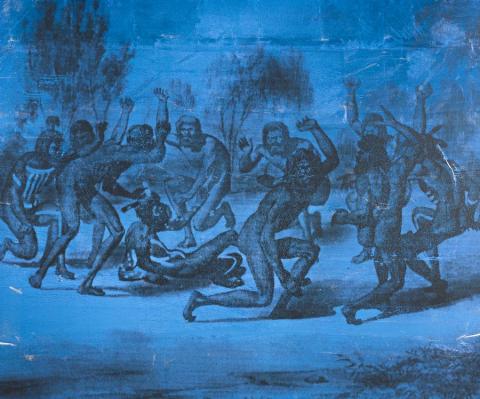THE ISLAND IV, 2008
Brook Andrew
mixed media on Belgian linen
250.0 x 300.0 cm
edition of 3
Tolarno Galleries, Melbourne
Private collection, Melbourne
Brook Andrew: Theme Park, AAMU, Museum of Contemporary Aboriginal Art, The Netherlands, 17 October 2008—13 April 2009 (another example), illus. in accompanying exhibition catalogue, p.4 (another example)
The Island V, 2008, collection of the Queensland Art Gallery, Brisbane
Between 1856 to 1857, German artist–scientist William Blandowski and his artist–assistant Gerard Krefft journeyed inland to the junction of the Darling and Murray Rivers. Commissioned by the Surveyor–General, the expedition was 'for the purpose of making investigations on the natural history of that district, and also, with a view of collecting as many specimens as possible for the National Museum, and marking the distribution of animal life along the route'.1 Whilst the expedition was a success, Blandowski was to slip quietly from history, the majority of his work from the period being dispersed in Germany after his return in 1860. In Australia only 27 completed plates remained; a portfolio of 200 plates languishing in the Museum of Natural History in Berlin. Intended by Blandowski as a compendium of geology, zoology and ethnography, the images which illustrate antipodean landscapes are characterized by a sense of wonder with equal measures of scientific sophistication and romantic response. As noted by Andrew Sayers when describing one of the plates, 'the composition of the huge granite boulders of Pattowatto silhouetted against a setting sun possesses an almost surreal air, with the apparently bizarre conjunction of a horse (presumable included to give scale to the boulders) and, somewhat incongruously, Aborigines smoking possums out of a hollow tree.'2
Here in The Island IV, Brook Andrew has transformed an image from Blandowski's Australien in 142 Photographischen Abbildungen, employing a screen printing technique involving coloured reflective foil on linen. The resulting work enmeshes lost or forgotten histories with contemporary ideologies. Traversing the fields of morality, cultural identity and perception, Brook Andrew revisits the humour and absurdity of these early imaginings.
We are physically reminded of the nature of history, written as they say by the victor, through the very act of viewing The Island IV. As observed by writer Anthony Gardner, 'as one moves around the image, the bodies pulse in and out from the surface, pulled into and drawn back to disappearance according to where we stand and the reflection of the light off the foil. In varying parts of the works, the image has worn away, been traumatised, by the stretching of the linen across the frame; pigment has been ripped from foil so that blind spots emerge in the image, echoing those developed culturally through persistent erasure of history. As a consequence, image and referent are continually invoked and then ungrasped, made and unmade through the motions of our viewing as much as the artist's mediations.'3
1. as quoted in Allen, H., Australia: William Blandowski's Illustrated Encyclopaedia of Aboriginal Australia, Aboriginal Studies Press, Canberra, 2010, p. 6
2. Sayers, A., Australian Art, Oxford University Press, United Kingdom, 2001, p. 49
3. Petitjean, G., Brook Andrew: Theme Park, AAMU, Museum of Contemporary Aboriginal Art, The Netherlands, 2008, p. 83
MERRYN SCHRIEVER
